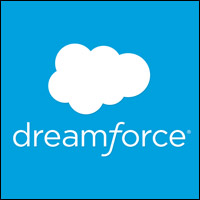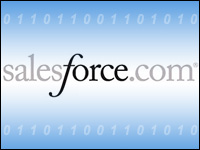
What a difference a decade makes. Ten years ago, the booths on the Dreamforce show floor were little more than outposts for widget-makers. Fast-forward to Dreamforce 2015, and one is struck by the number, variety, and size of the partner community.That’s only part of the story, though. Often out of sight is the sizable display of talent that has consolidated around Salesforce from other industry sources.
A little more than 10 years ago, Siebel was the top dog — the first billion-dollar CRM company — and it held a large proportion of the available CRM talent. Salesforce was a precocious upstart vendor of SaaS computing. At this year’s Dreamforce, there were numerous Siebel alumni drinking the Salesforce1 Kool-Aid.
The Gang’s All Here
Former Siebel EVP, David Schmaier, after a sabbatical from the industry, started Vlocity, a company dedicated to making vertical market apps for healthcare, financial services and insurance.
Vlocity takes a page from Veeva, a highly successful company in the pharmaceutical space that Siebel alumnus Matt Wallach cofounded with Peter Gassner, formerly of Salesforce and PeopleSoft.
Also prowling the floor was Anthony Lye, formerly tied to Siebel, Oracle and others, and now CEO of HotSchedules, which offers a cloud service application for the restaurant industry.
Ex-Siebel stars Kevin Nix and Narina Sippy are spinning up Stellar Loyalty.
Steve Mankoff, now a general partner with TDF Ventures, was keeping tabs on some of his investments.
Although Bruce Cleveland, former GM of Siebel and now general partner with InterWest Partners, was not seen, his presence was felt in companies as diverse as Aria and Vlocity.
Having so many old CRM hands concentrated as they are around Salesforce likely will help further accelerate the company’s growth. Certainly the potential is there. In his partner keynote, EVP Tyler Prince revealed a US$135 billion revenue opportunity calculated by Salesforce over the next five years. Even if you discount that by a large factor, that still leaves a lot of billions. That’s one reason so many industry veterans are attracted to Dreamforce.
The companies in attendance have grown in stature dramatically over the last decade, and the show floor included many public companies or future IPO outfits including, in no order, Xactly, FinancialForce, Zuora, Vlocity, Apttus, Full Circle Insights and about 390 others.
Many of this group rented storefronts around the Moscone Center to provide meeting space and hospitality to their customers and prospects. Most also sponsored big parties and scheduled user events coinciding with Dreamforce to further induce customers to attend. Apttus raffled off a Tesla, and FinancialForce sponsored a scotch tasting. (Full disclosure: I tasted the scotch but did not win the Tesla).
Deep Thoughts
At the same time, Salesforce was trying to get a few messages out, so there was plenty of discussion of the new Lightning UI for desktops and laptops. Significantly, the UI was announced last year, but only for mobile devices — a demonstration of the importance of developing for the small screen first these days.
The company also announced SalesforceIQ, a rebranded absorption of RelateIQ for SMBs and the enterprise. The IQ product is designed to capture inferential data and turn it into useful things like new meeting appointments and follow-up actions without requiring the rep to enter the data manually.
To go with Lightning, Salesforce introduced an IoT cloud powered by Thunder, the company’s initiative to corral the billions of devices that will need cloud connections by 2020. There were also specific keynotes for every cloud in the company’s kit, and those announcements were way too numerous for this piece. Fortunately, they are all preserved on YouTube.
The biggest bang comes whenever Salesforce assembles a gang of smart people to talk about the future. They don’t do it every year, and perhaps that’s wise since major change of the type they like to discuss follows more of a punctuated course, like an EKG.
This time they had a lively discussion about what happens when Moore’s Law and Metcalf’s Law collide with business in a big way. That intersection is best explored at length in The Second Machine Age and Race Against the Machine, both by Erik Brynjolfsson and Andrew McAfee of MIT’s Sloan School, and their ideas were referenced more than once.
You may have read those names here a few times prior to this. The questions they ask — which we are still attempting to answer — are of this type: What happens when machine intelligence becomes good enough to begin replacing humans at knowledge work?
We’ve all seen automation replace rote manual activities in business, thus boosting productivity. The standard explanation is that the human resources are liberated to pursue higher-level value-add. However, the rise of the service economy, with its lower wages and hard-to-find jobs, suggests that the future might not be as rosy. What happens when “there’s an app for that” means a pink slip?
Happy outcomes don’t come automatically, but since the Industrial Revolution, history suggests not only that new jobs do spring up, but also that new kinds of jobs become available. An easy example is the software industry analyst. No one I know went to school to become an analyst — I certainly didn’t.
There is no room for complacency, though. Machines now are capable of writing reports in reasonably good English (though doubtless without the same panache as yours truly). It’s different this time; replacing manual labor is one thing, but replacing thinking is much different. It will be a very different ballgame when everyone has a computer and a 3D printer, as Jeremy Rifkin writes in The Zero Marginal Cost Society. That’s something the Salesforce brain trust didn’t get to this time.
Deep questions aside, it’s inescapable that the next shift will be in the front office. The enterprise will be adopting many of the platform technologies displayed on the show floor in order to support more automated processes, which rapidly are replacing the transactions we’ve grown to accept in many vendor-customer interactions.
“Process” isn’t exactly a new watchword yet, but vendors like Salesforce and others are delivering increasingly capable suites that will make the shift to process rapid, once it officially starts. (Actually, it has started — you might not see it, but you don’t want to be the last adopter.)
Women in Tech
Kudos to founders Parker Harris and Marc Benioff for putting themselves on the spot and taking on some tough issues, like sponsoring a Women’s Leadership Summit. They sat down for some interesting dialog and hard questions from Kara Swisher, co-executive editor at Re/code, about how to provide better opportunities for women in the tech industry.
It was not an easy discussion, and if you watch the video, you can see everyone trying to puzzle it all out. However, Benioff and Harris didn’t shrink from it, and they expressed a commitment to put the issue at the top of their agenda. (Heck, the summit was their idea).
Though more needs to be done, you can’t put Salesforce, even today, in the same category of many older tech firms, and the presence of women at the conference was notable. Still, we need more.
To net this out, Dreamforce had its requisite cornucopia of products, announcements and invention, but it also offered some provocative insights into the future of work and our society — two things that will drive demand for its products and services long after this year’s new whiz-bangs are history. That’s why I go to Dreamforce.
























































